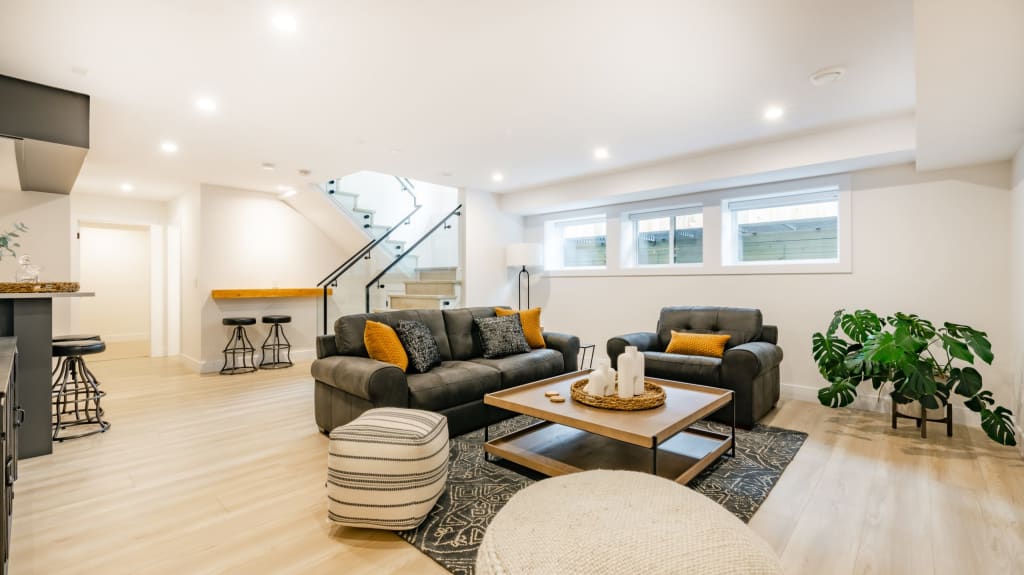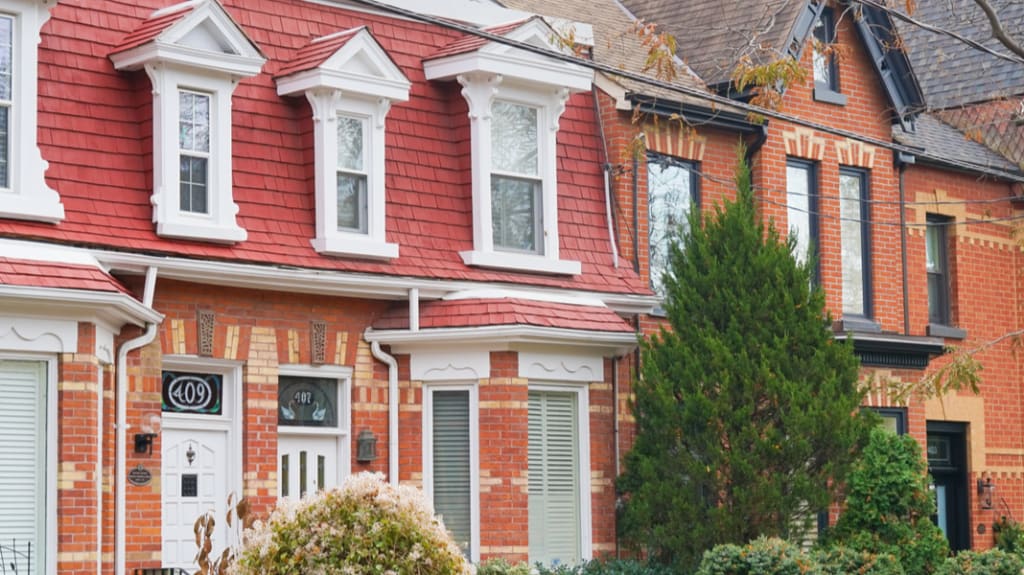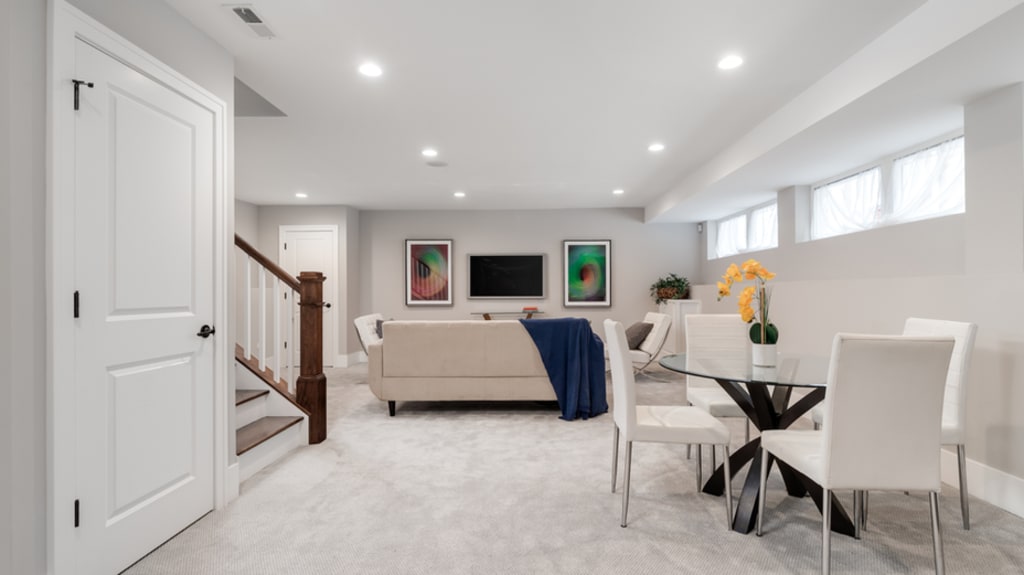Homeowners everywhere with to-die-for designs and kitchens that belong on magazine covers are hiding a dirty not-so-little secret. Lurking in these homes, behind seemingly innocent doors or down a set of stairs that trails from view, are sad, neglected basements. This part of the home is often last on the mind when it comes to design, leading to a lot of square footage being underutilized or wasted entirely. If you’re looking to give your basement a facelift, one of the biggest questions you may have is, “What do I do with the floors?” Read on to find out how some of today’s most popular basement flooring materials can help you unlock your home’s hidden potential and bring your gloomy basement into the light!
Important factors to consider when choosing your basement flooring
The flooring you choose for your basement is vital as it can affect the overall appearance, functionality, and longevity of the space. Here are some factors to consider to ensure you make the right choice.
Style and comfort
What would be the point of spending time and money replacing your basement floors if you don’t enjoy the finished space? It’s not enough for a flooring material to just be strong and durable; it needs to fit into your overall design and be comfortable enough that you actually want to use your basement.

Warmth
Basements are often the coldest room in the house. What’s worse is that their appearance will often make them seem even colder than they really are. Choosing the right flooring means considering both real and perceived warmth. Some materials will be more suited to adding insulation to basements in colder climates, while others may offer warm tones and rich textures to fight off the gloom of being below ground. You can use lighting to make your space seem warmer, but, without the right finishes, it will still feel sterile and cold.
Moisture resistance
One of the most important factors to consider for your renovation is moisture resistance. You do not want to find yourself facing problems with basement humidity as they can be annoying and costly to fix. Flooring materials that are not designed for high humidity environments will not last long in basements, requiring replacing much sooner and costing more over time than moisture-resistant options. Excess humidity in the space can also lead to issues such as warping and mould throughout, making it one of the more costly problems you can have in your home. Save yourself time and money by doing your research, by consulting professionals and choosing the right option for your climate and home.
Maintenance and durability
How long do you want your new floors to last? How much wear will they have to endure on a regular basis? How much of your time and energy are you willing to spend keeping them looking shiny and new? Asking yourself these questions can help whittle down the list of basement flooring ideas to find what best meets your needs, as well as help know what to expect when it comes to the care and wear of specific products.
Installation
Installation is a key consideration with renovations, particularly if you intend to complete the work yourself. Some basement flooring options cost more in labour for installation, while others require the space to be unoccupied for extended periods of time. Always ensure you do your research and understand what it takes to get your dream material into your home.
Types of basement flooring
Now that you’ve identified your needs, let’s go over the most popular basement flooring ideas.
Engineered wood
It’s hard not to fall in love with the look and feel of hardwood, but it’s not exactly compatible with the high levels of humidity found in basements. For the warm, natural feel of wood without the risk of warping, engineered hardwood is a wonderful basement flooring option. This type of flooring will show wear after time but can usually be sanded down and refinished a few times before needing to be replaced.

Laminate flooring
Whether planks or tiles, laminate is one of the easiest types of flooring to install. Popular installation styles available include click-together and stick-on. Laminate flooring can be seen as cheap, and it certainly can be, but there are higher-end options available that do a good job of mimicking other materials. As it is composed of several layers of resin-impregnated, treated fibres, laminate is unlikely to last as long as other types of flooring. It is not generally recommended in humid areas or high-traffic zones. While it is easier to maintain in the short term, you should expect to need to replace it sooner than other basement flooring options.

Ceramic or porcelain tile
Tile is a popular choice for any area with high humidity. There is a vast variety of sizes, shapes, and patterns to choose from, meaning you can find something to fit any design. Ceramic is more porous and less durable than porcelain but more budget friendly. Tile is often used over in-floor heating, meaning this normally cool material could be used to help keep your feet toasty all winter.

Sheet vinyl flooring
If you want something affordable and aesthetic, sheet vinyl is a great option. Each colour or pattern is printed on this material, and some companies even offer custom services – they’ll turn any design or photograph into vinyl flooring! That said, it’s not without its downfalls. This basement flooring option is quite thin, offering little insulation or warmth during the colder months. It also highlights any imperfections underneath it, so you’ll need to refinish your floor if it’s uneven before installation.

Luxury vinyl flooring
This popular material is similar to laminate flooring but far more durable and moisture resistant. Luxury vinyl is imitating some other materials so well it can be hard to tell the difference. It’s also easy to install, meaning you can get back to enjoying the comfort of your new space more quickly.

Epoxy
When looking into basement flooring ideas, be sure not to overlook epoxy. It’s durable and low maintenance, making it ideal if you want to get a lot of use out of your basement. There are some drawbacks, such as heel impact noise on the floor. It is also a material that requires a completely even surface underneath since any imperfections will show through.
Because it’s a hard material, heel impact noise can be annoying.

Cork flooring
Cork is a material that has gained popularity over the last few years. It is sustainable and has shock-absorbing properties, making it an ideal choice for individuals with joint issues or anyone planning to spend a good deal of time on their feet. Cork is non-absorbent so moisture is not a concern; however, it does not hold up well to wear.

Finished concrete
If you’re thinking of redoing your basement floors, then it’s only natural to first think of how you might use what you already have. The two ways we see concrete finished in basements are either sealed or polished. Sealing concrete does not hold up to foot traffic, so it requires regular maintenance and resealing. Polishing concrete gives it a high-gloss finish. Proper installation involves adding a sealant that lowers the porosity of the material. Polished concrete is low maintenance.

Rubber flooring
Are you at the gym so much you feel like you live there? Now you can bring that feeling home with rubber flooring for your basement! Rubber is shock absorbent, making it ideal for individuals with joint pain. It can be great for a home workout space or a safe indoor play space for kids. Rubber flooring can be time-consuming to install in large spaces but can last for decades.

Painted flooring
Painting your floor opens up a world of options. You can use a solid colour, create a repeating pattern, or do something wild and original. Unfortunately, paint does not last long on floors. It will require touch-ups, particularly in high-traffic areas. While buying more paint to fix it is cheap and easy enough, it may not be something you want to do over and over for the life of your floor.

Carpet
Carpet (or carpet tiles, as is on trend) is a classic choice for basement flooring. It is quick and easy to install, there are options to suit a variety of budgets, and it is easy to find just the right colour and texture to fit your design. They also add much-needed warmth and insulation to thaw icy toes. If your basement is sealed properly, carpet can be a great selection. If not, you may end up with musty or even mouldy carpets.
Upgrade your home with beautiful basement flooring
Basements should be more than just the neglected catch-all for the rest of the house. A good design can give you and your family room to enjoy life, and your home, to the fullest. Choosing the right basement flooring means giving your remodel a solid foundation.
Are you looking to learn more? We have expert knowledge and advice for all your basement needs, from preparing for your renovation to converting your basement into an apartment.





